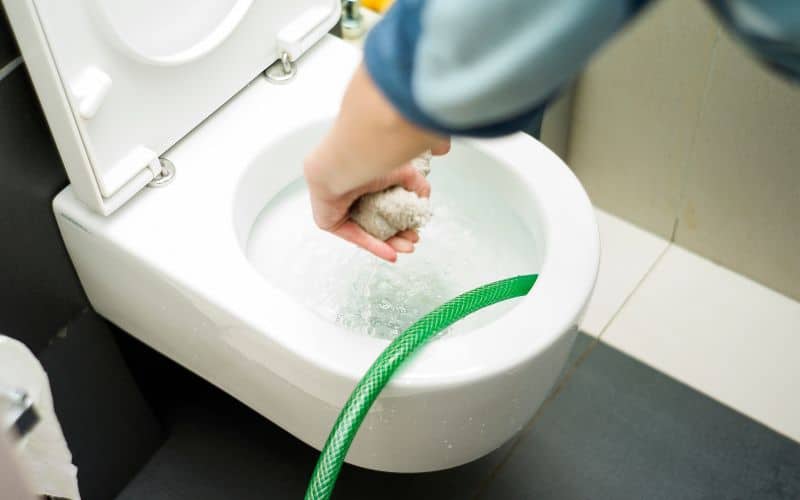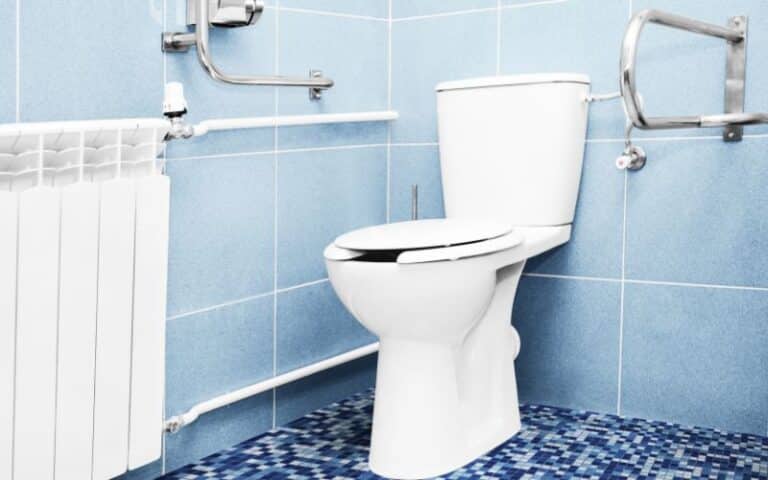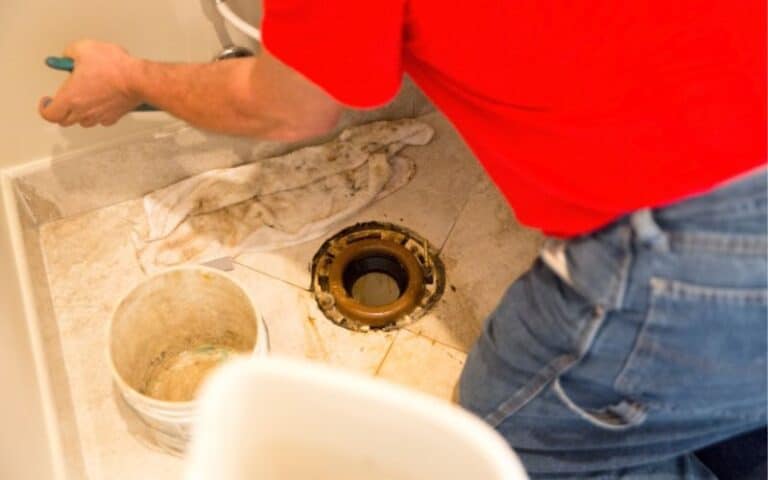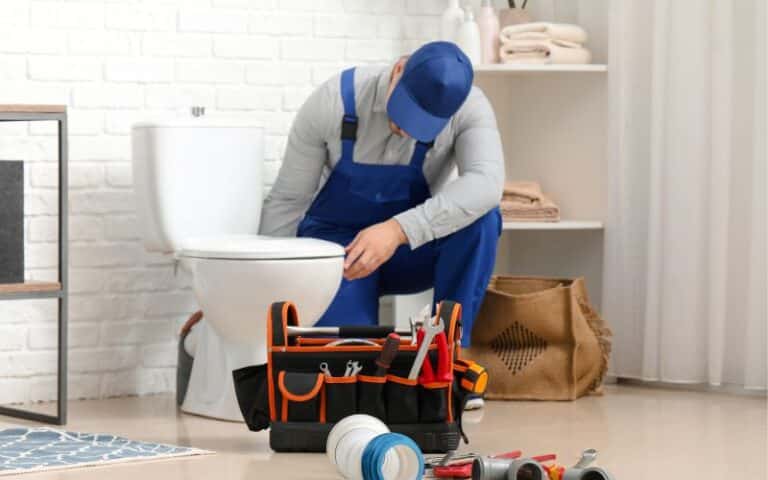Imagine coming home from a hectic day to find your toilet overflowing and leaking through the ceiling.
It surely is a messy and frustrating situation requiring immediate attention.
You may wonder what caused such a problem and if there may have been signs you failed to miss.
Experiencing this regardless of the state of your building is shocking. And the two prominent questions in your head are: what caused this, and how do I fix it?
A damaged wax seal is one primary cause of toilet overflow that leaks through ceilings between the toilet and ceiling. But this overflow can also result from clogged drains, faulty valves, & a problematic flushing mechanism. Fortunately, you can fix the issue. Begin by cleaning the flooded water, then call an experienced plumber to repair the seal and patch any holes.
You’ll want to read this article to the end as we explore effective methods of stopping a toilet overflow.
We’ll also discuss tips to prevent this problem and fix the underlying issues causing the leak.
Why Would a Second-floor Toilet Leak Into the Ceiling?

If you’ve noticed the ceiling under your toilet leaking into your ceiling, you have a damaged wax seal ring. You need to know the science behind this to understand how this occurred.
The wax seal is a ring between your toilet fixture and the ceiling to provide airtight security and avert a water or sewer gas escape.
Depending on storage, a wax seal’s shelf life isn’t defined, as it could last long or short. Furthermore, after installation, a wax seal should have similar longevity to the toilet.
However, you may need to change them, especially in. the case of a leak that seeps through the ceiling.
It’s important to be able to detect a damaged wax ring before it worsens to prevent issues like this. Hence, this article discusses how to spot it early enough.
In a wax issue, you may enable the problem each time you flush, allowing water to permeate the ceiling. This consistency, over time, weakens the ceiling enough to cause a leak.
In addition, leakages result from faulty water supply lines connected to the toilet or sink. This leak may come from the joint in the water pipes when not tightened.
It may be a loose connection issue. It could also be a damaged drain pipe in the ceiling. But a clogged toilet is also at blame, so the tips below will only work if you adhere to them.
To prevent these overflowing toilets and leakages, you can do the following:
- Don’t flush anything that won’t dissolve in the toilet bowl. It’s best to use soft tissue paper.
- Flush with moderate water to prevent overflowing the toilet bowl.
- Avoid harsh cleaning agents as they can cause leakage by destroying the porcelain.
- Examine the toilet frequently for cracks.
Can the Toilet Overflow With Poop Into the Ceiling?
Unfortunately, your toilet can overflow with poop, but when leaking into the ceiling, only the toxic waste water will seep through.
An exception is if a hole in the ceiling allows the poop to pass through. This situation is extremely messy and poses a health risk.
But you must assess the situation and work to fix it immediately. To begin, you should identify the cause of such a problem.
Toilet overflow occurs when there’s a blockage in the plumbing or if you have a faulty flushing system.
As a result, when you flush after use, the water and waste can\t pass through the pipes into the sewer due to the blockage, causing an overflow.
Primarily, this also occurs when one uses a lot of toilet paper, especially in excessive amounts.
It may also stem from flushing foreign materials like sanitary products, baby wipes, and excessive solid waste.
Due to the blockage, the waste and water return instead of going away. And if there’s enough pressure, the waste can overflow and reach the ceiling.
Clogging is the underlying cause of it. Hence, it’s advisable to be careful of what you flush.
You can learn more about the reasons for a clogged toilet and how to avoid it. This knowledge will help you prevent overflowing toilets in your homes.
How to Safely Clean Up After a Poop Overflow in Toilets?
Although common, this problem is a health hazard, so it’s necessary to clean up carefully, and we’ve explained how below.
- To begin, turn off the water supply. You can do this at the water turnoff valve or the supply line.
- Next, unclog the toilet with an auger. Although plungers are more familiar, these augers work best in extreme situations.
- Dry up the standing water and clean the towels or mops properly afterward.
- Dry the bathroom. Depending on the case’s severity, you may need a fan or fans.
- And most importantly, disinfect the toilet and ceiling and every other infected or nearby place properly.
How to Fix Toilet Overflow Leaking Through the Ceiling?
When you notice the main cause or other causes of your toilet overflow and ceiling leakage, it’s best to fix it as soon as possible.
The following step-by-step guide will prove effective.
#1. Turn Off the Water Supply
Ensure to do this first step from the water supply valve or line to prevent more water from overflowing. Afterward, proceed to the subsequent steps.
#2. Dry the Toilet Floor/Ceiling
You can only see the problem clearly if the floor is dried. Use a fresh rag or fan to do this, and afterward, dispose of the cloth or wash properly.
#3. Repair the Ceiling
The ceiling may have holes, a damaged wax ring, and a faulty supply tube. You can fix the hole with a patch kit or use a dry cover to repair it.
#4. Repair the Upstairs Overflowed Toilet Ceiling
It could be a wax ring or supply tube issue. For the wax ring, drain the toilet and remove it, then detach the previous wax ring and toilet flange tighteners.
Install the new wax ring, fix the flange bolts, and put back the toilet. Lastly, for the supply tube, shut off the toilet’s water supply and drain the bowl.
Unfasten all nuts joining the supply line, connect a new one, and turn on the water.
#5. Fix Any Water Leakage
You may need to hire a plumber as the problem could be from pipes or other areas. And do it immediately after fixing other problems to avoid worsening it again.
Will the Insurance Company Fix Toilet Overflow From a Neighbor’s Toilet Into Your Ceiling?
Generally, insurance coverage for toilet overflow from a neighbor depends on the precise policy governing your building.
The situation leading up to the event also influences the possibility of insurance coverage.
Most times, if the overflow was a sudden mishap caused by a plumbing problem or your neighbor’s carelessness, your insurance may cover it.
But if the fault was from you, insurance may not cover it.
Reviewing your insurance policy and understanding the specific coverage and exclusions related to water damage is advisable.
This article will prove beneficial. It’s vital to be mindful in using your toilet to prevent causing problems for others and yourself.
The table below highlights causes, signs, effects, prevention, and what to do during toilet overflows. This simple breakdown will guide you if you are ever in such a situation.
| Causes | Signs | Effects | Prevention/Maintenance | Solution |
|---|---|---|---|---|
| Clogged pipes or drains. | Slow draining or gurgling sounds. | Damage to the floor and walls. | Regular toilet inspection/cleaning. | Turn off the toilet’s water. |
| Faulty toilet components. | Water rises to the toilet bowl’s brim. | Contamination to the nearby area. | Avoid flushing foreign materials. | Clear any blockages. |
| Excessive water pressure. | Foul odors from the toilet or drains. | Potential health hazards. | Use a plunger/auger to unclog. | Clean affected areas well. |
| Improper flushing habits. | Leaks around the toilet’s base. | Structural damage to the ceiling. | Use pressure-reducing valves. | Assess and repair all damages. |
Does a Toilet Leak in the Ceiling Cause Mold?
Toilet leaks in the ceiling can cause mold growth because the dampness in the ceiling is a perfect place for it to thrive.
Mold spores are already in the air waiting for moisture, and when your toilet leak creates one for them, they act immediately.
This mold growth usually happens a day or two after an untreated leak occurs. Since this mold is dangerous, you must remove it from your ceiling.
But before that, fix the underlying cause of the leak to avoid recurring water damage and mold growth.
To begin:
#1. Gear Up
Prioritize your safety, so wear protective gloves, goggles, and a nose mask to avoid breathing in mold-infected air.
#2. Contain the Infected Region
You can only remove mold if the infected area is small. It’s best to keep it that way. Hence, use tarps or plastic sheets to seal off the mold area to prevent it from spreading.
#3. Dispose of Affected Items
If the mold has deeply entered the drywall or ceiling tiles, you must replace them with new ones, especially if the damage is too much.
#4. Clean and Dry the Area
Use a disinfectant and a water and detergent mixture to clean the area. Afterward, dry the area and use a fan to make it faster.’
#5. Prevent Potential Mold Growth
Fix any other plumbing or toilet issues that can cause future mold growth to prevent the mold from returning.
Will a Toilet Overflow Into the Ceiling Affect Your Light Fixtures?
In most cases, when a toilet overflows into the ceiling, it can affect your light fixture.
The overflow water may extend to your home’s electrical wiring, causing a short circuit or, worse, a fire hazard. Address this immediately to avoid severe damage.
If this happens, turn off the water and electricity, dry the area, and have a plumber and electrician handle the issue.






